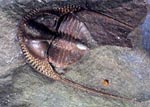Spineless Critters First
The Cambrian Period is
the time in Earth's history when more new varieties of life forms
developed than at any other time. Together with the Ordovician
(oar-doh-VISH-ee-in) Period, this was known as the 'Age of
Invertebrates'. Invertebrates are
animals without backbones, such as snails and clams.
The first creatures with hard parts (shells and skeletons), and most of
our familiar animal types develop at this time. For all this new
development, there are still no plants or animals on land yet.
This time of rapid
innvertebrate development is sometimes referred to as the 'Cambrian
Explosion'. It is also known as the 'Age of Trilobites'.
Trilobite fossils start to show up all over the world in rocks
that date to this time period. But remember, NH has no 'good'
fossils, because we have no sedimentary rocks. We had sedimentary
rocks here…what happened to them? There are trilobites in Maine
and Massachussetts rocks.
(see: http://www.gsmmaine.org/)
During this time, most of the
tectonic plates were gathered together into a continent known as Gondwana.
The 'land' that would one day be New Hampshire was ocean floor,
near the South Pole, and off the coast of what would become South
America! (See map at right.)
Poisonous Air?
For most of the 2
billion or so years before the Cambrian Period (known as the
Precambrian Period), life on Earth was limited to single celled anaerobic bacteria
living in the oceans. Anearobic means that no oxygen was used or
made by the bacteria. In fact, these bacteria survived best
without oxygen. The atmosphere at that time had very little
oxygen in it. In fact, you wouldn't have been able to breathe the
Earth's air at that time and survive.
Towards the end of the
Precambrian Period, a new kind of bacteria - cyanobacteria
[sigh-ANN-oh bak-teer-ee-uh] (formerly known as blue green algae) was
developing in the oceans. Cyanobacteria tried something new:
it used the Sun's energy, combined with nutrients in the water,
to make a kind of sugar. This sugar was used as an energy source
(food) for the cyanobacteria to grow and reproduce.
This was the introduction of photosynthesis
('photo' meaning 'light' and 'synthesis' meaning 'to make from'.)
Photosynthesis produces carbon dioxide for plants to use and
gives off oxygen as a waste product. Pure oxygen happens to be
poisonous to anaerobic bacteria.
This was unfortunate for the
anaerobic bacteria, but fortunate for us!
Over time, more and more
cyanobacteria populated the Earth, causing the share of oxygen in the
atmosphere to increase. The development of cyanobacteria
made it possible for photosynthetic plant life to prosper.
Today, oxygen makes up about
21% of the Earth's atmosphere and the anaerobic bacteria is reduced to
living in places where oxygen is scarce and conditions make it hard for
other organisms to survive. They continue to live in mud, boiling
hot springs and in sediments at the bottom of the ocean.
|
|
Trilobites were the ancient
ancestors of today's horseshoe crabs. The name 'trilobite'
describes the body of these creatures of relatively shallow, warm
ancient seas. 'Tri' means three, and 'lobes' are rounded body
segments. Therefore, trilobites had three rounded body sections
(seen here as they run from head to tail down the length of the
animal's body).
| The Age of Trilobites |
|
 Trilobites
were the ancient ancestors of today's horseshoe crabs. The name
'trilobite' describes the body of these creatures of relatively
shallow, warm ancient seas. 'Tri' means three, and 'lobes' are
rounded body segments. Therefore,
trilobites had three rounded body sections (seen here as they run from
head to tail down the length of the animal's body). Trilobites
were the ancient ancestors of today's horseshoe crabs. The name
'trilobite' describes the body of these creatures of relatively
shallow, warm ancient seas. 'Tri' means three, and 'lobes' are
rounded body segments. Therefore,
trilobites had three rounded body sections (seen here as they run from
head to tail down the length of the animal's body).
(Click on the image for a closer look.)
Image Credit: Photo courtesy of National Museum of Natural
History, Smithsonian Institution
|
| The
Granite State Down Under |
|

This view of the arrangement of the Earth's tectonic
plates and bodies of water represent what geologists think the Earth
looked like during the Cambrian Period. At the time, parts of the
Earth that would one day be New Hampshire were located near the South
Pole!
Today, New Hampshire is located in the Northern
Hemisphere nearly half way to the North Pole.
(Click
on the image for a closer look.)
Image Credit:
Christopher Scotese; scotese.com
|
The First
Earthlings
These
bacteria represent some of the oldest forms of life on Earth.
|

(Click on the image for a closer
look.)
Image
credit: Centers for Disease Control.
|
Next Page
|